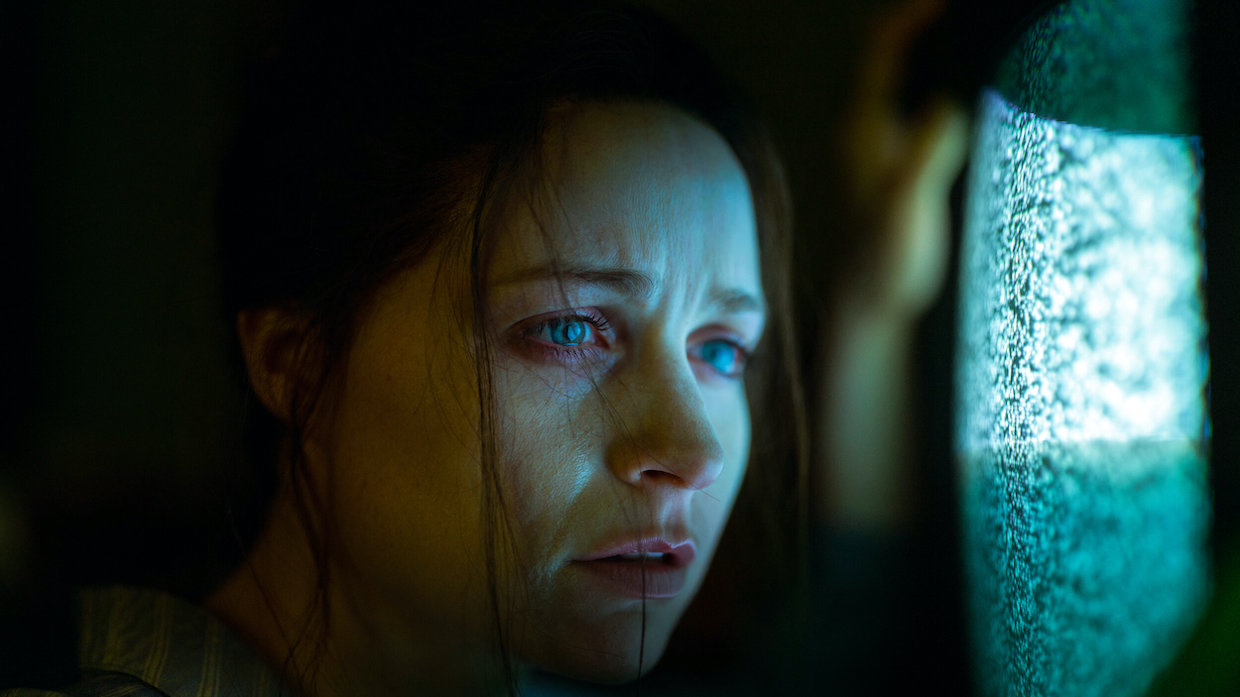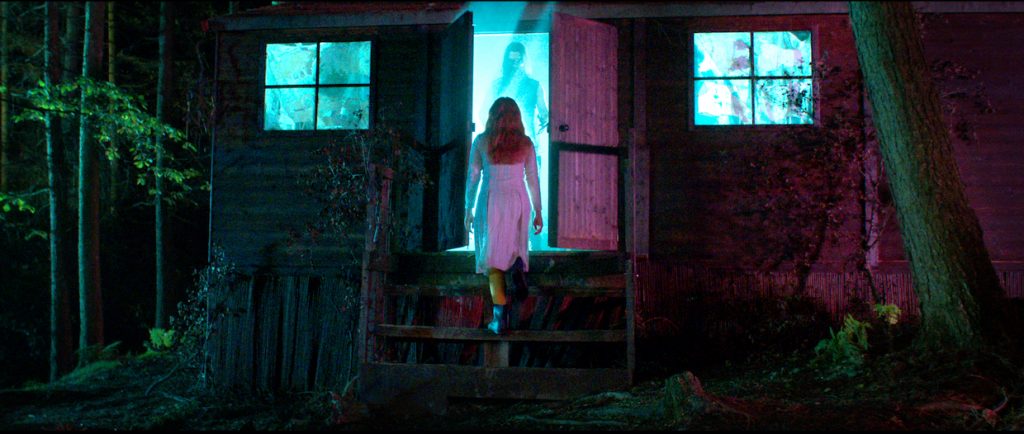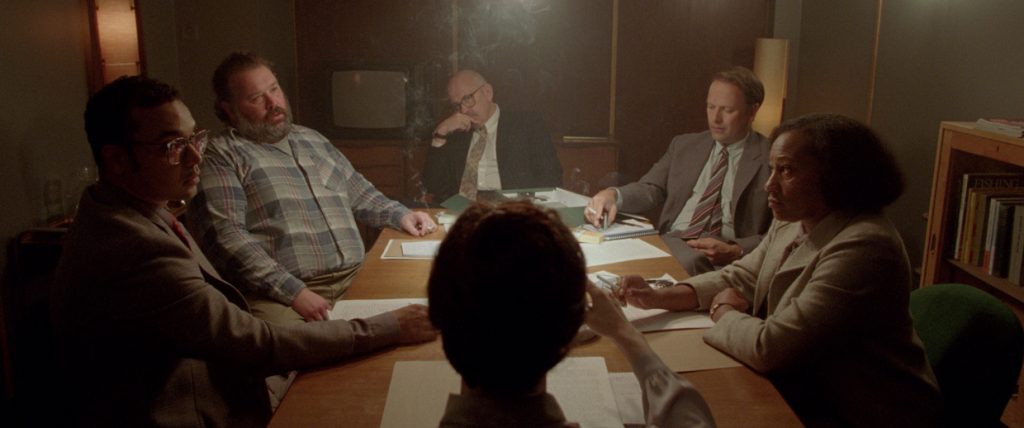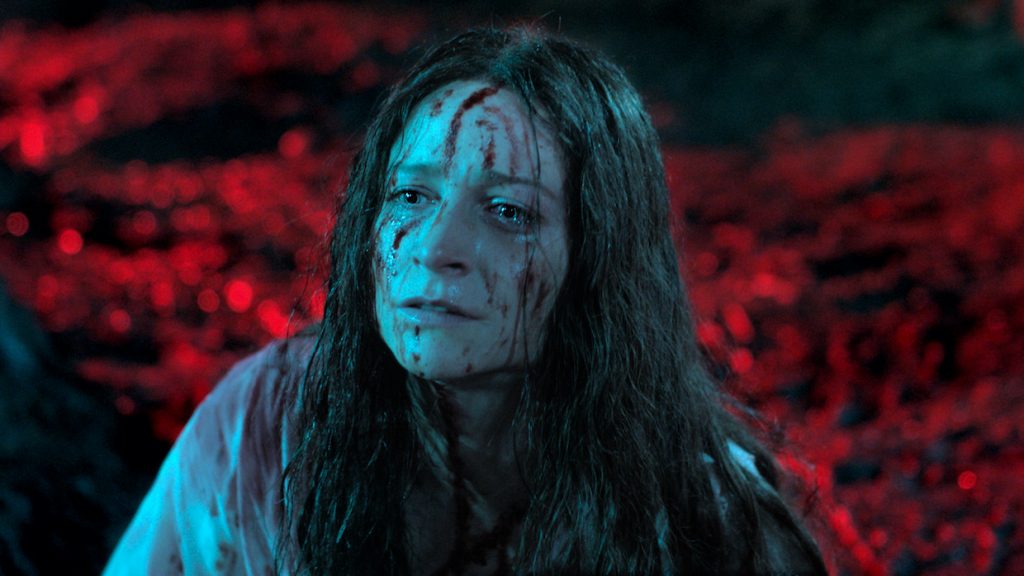 Back to selection
Back to selection
Shutter Angles
Conversations with DPs, directors and below-the-line crew by Matt Mulcahey
“If You’re Not Scared of an Old Short End, Then You Can Have It”: DP Annika Summerson on Censor
 Niamh Algar in Censor (Photo by Maria Lax, courtesy of Magnet Releasing)
Niamh Algar in Censor (Photo by Maria Lax, courtesy of Magnet Releasing) In the early 1980s, as Britain took a rightward turn that mirrored America’s own shift, the country’s bastions of righteousness took aim at the nascent videocassette market. Before home video releases were placed under the purview of the British Board of Film Classification, the job of protecting Britons from gory practical effects fell to the Director of Public Prosecutions. That office ultimately compiled a list of 72 films it believed were in violation of the country’s Obscene Publications Act. Films on the list became known as “video nasties.”
Cinematographer Annika Summerson has seen her fair share of them. That’s largely because of director Prano Bailey-Bond, her collaborator on the new horror film Censor as well as Summerson’s former roommate. “I’ve watched so many of them,” laughed Summerson, a Swedish-born British transplant who first befriend Bailey-Bond at university. “Prano is a walking library of knowledge when it comes to horror films and video nasties. When we lived together, it was just film after film. I really enjoyed them, but I did end up watching a lot of things like Cannibal Holocaust and The Driller Killer.”
Those are exactly the types of films Censor’s protagonist Enid (played by Niamh Algar) would take great pleasure in cutting to pieces to protect the public from their corrupting influence. However, the edges of Enid’s buttoned-up exterior begin to fray when she’s tasked with reviewing an archival horror film titled Don’t Go in the Church that eerily resembles the circumstances of her sister’s childhood disappearance.
While the “video nasty” list included such grimy exploitation as I Spit on Your Grave and Wes Craven’s The Last House on the Left, the verboten collection also featured colorful, inscrutably surreal work from directors like Dario Argento and Lucio Fulci. “We wanted Censor to be a mix between the two,” said Summerson. “We wanted it to feel somewhere in the middle of a cheap, trashy film and a classy one while remaining true to the color palettes of some of the Argento movies that we took inspiration from.”
Censor hits theaters on June 11th and VOD on June 18th.
Filmmaker: Let’s start with breaking down all the different formats you employed on Censor.
Summerson: We used 35mm for the bulk of it. Basically most everything is 35mm up until the night exteriors in the forest at the end, then we switched to digital with a Sony Venice. It was a requirement from the financiers, because there was going to be VFX and children in those scenes. Then, for the final scene, we switched back to film. There’s a couple of scenes of Super 8, some that actually came from a short film Prano and I did in 2014 called Nasty, then some new Super 8 footage we shot of Enid in the forest being filmed by [the movie’s fictional Don’t Go in the Church director] Frederick North. Then there’s a news report in the film on a 1980s estate that was shot on a Panasonic M40, I think it was, which is an old VHS camera.
There’s also one iPhone shot. We were about to do a few pickups [last] March when COVID hit and we got postponed. So, during lockdown Prano and I just did one shot with an iPhone of her at home covered in blood with a knife. We actually tried to shoot that on a really old camera that Prano had in the attic, but that didn’t work, so we ended up doing it with an iPhone.
Filmmaker: How did you track down that Panasonic VHS camera?
Summerson: It was really hard to get ahold of, actually. We did record with another home video camera at the same time in case the VHS camera didn’t work. But the hardest thing to find was a VHS player to check the tape afterward. Me and Prano stayed in a flat together up in Leeds during the shoot and had to have a VHS player delivered, but then we didn’t have the right cables, because you can’t just plug them into the back of TV’s anymore. In the end, it worked.
Filmmaker: For that 8mm footage shot by the Frederick North character, did you let the actor actually film with the camera he’s holding on screen?
Summerson: No, I did it. It was so dark you couldn’t see through the viewfinder and the camera had to be focused manually, so I had to do it. I would’ve loved to have given it to him, though. I’m all up for things like that. I’m not so precious.
Filmmaker: The camera North is using on screen has this light rigged on top of it. Was that an actual component of a real Super 8 camera or did the props department rig that up?
Summerson: No, we did it. Apparently it was not correct for the period to have a light on top of that camera, but we decided it should have one anyway. Then when we turned around and shot coverage of Enid, we just had a normal film light we used that was stronger. The prop Super 8 camera wasn’t even the Super 8 camera I actually shot that footage on. The prop camera is actually my dad’s old camera.
Filmmaker: Some of the films we see Enid reviewing are actual “video nasties,” like Abel Ferrara’s The Driller Killer. But you made a few faux-nasties of your own too. Did you only do a few shots for each “fake movie” or did you shoot full scenes?
Summerson: We literally shot exactly what we needed. Prano is also an editor so she’s very strict and she knows exactly the shots she wants. We shotlisted pretty much the whole film. The exception was the Frederick North film Asunder, because when Enid is watching it she keeps rewinding the tape. So, we had to record loads of scenes that were just going to be rewound on screen and that was stressful because we were really short on stock.
Filmmaker: The film is set in 1985 and, on some level, you’re shooting on 35mm to pay homage to the look of that era. But film stocks now—and that pretty much means Kodak Vision3—are so much cleaner than the stocks the “video nasties” were shot on.
Summerson: You’re totally right. The stocks are so good now. We were actually thinking about shooting 16mm for a while just because we wanted more grain. Our short film Nasty was shot on 16mm, so it was in the back of our minds. I did use softer lenses—the Canon K35s—and I used some filters as well. I tend to use Black Satin regularly, then for some of the effects I used heavier filters like fog filters. For some scenes we also pushed the stock to make it a little bit grainier, but that’s expensive. That’s an extra cost in the lab. So it wasn’t something we could do for the whole film, unfortunately.
Filmmaker: There’s actually an “in association with” credit for Kodak and Cinelab London at the start of the film. Did they help out with stock and lab costs?
Summerson: I’m not involved in the distribution of credits and budgets, but I know that Kodak did help us out with re-cans and leftover stock from other productions and things like that. I’ve known Sam Clark at Kodak for 15 years and he’s always been a champion of indie filmmakers. For example, if you’re not scared of an old short end, then you can have it. You can’t be picky sometimes. You make do with what you’ve been given and you make it work.

Filmmaker: Censor is full of saturated colors that are reminiscent of the Italian horror masters like Argento, Fulci and Mario Bava. How did you achieve those colors? With LED lights like the Arri SkyPanels, you can actually dial in a specific gel. So you can program in, say, a certain Lee filter number. But does that actually give you an identical color compared to using the same physical gel on a unit?
Summerson: We did have some SkyPanels with us that we used, but we also gelled old school HMIs and Fresnels, so there was a mix. I come from a lighting background, so I started out in lighting before there were LEDs. I love LEDs, but the heads are quite often more expensive now. Funnily enough, I’m doing tests for a new production at the moment and I tested five different gels of red yesterday on three different sources—an HMI, a Fresnel and a SkyPanel—and the reds came out looking almost exactly the same. I was like, “How is this possible?” None of the other colors did, but the reds were remarkably similar.
Filmmaker: When you were prepping Censor and you were looking for the right red or cyan, did you already know from your experience as an electric which gel would give you the look you wanted? Or did you test different options?
Summerson: In my head I do have a good back catalogue of gels from working as a spark, but I do like to run tests for each production just to see the combination of colors, and also just to see what it does on that particular camera with those particular lenses and those particular costumes. The variables change, so even though I have a good notion of what I want to start with—like I might say, “I really want to try the straw tint and cyan”—I’ll try out a lot of colors similar to that and come to a decision.
Filmmaker: You mentioned shooting on the K35s. Those are late 70s, early 80s glass—so, close to the era that the film is set in. Had you used them before?
Summerson: I had used them for commercials, so I knew the qualities they have and the type of flaring and softness they have. That was quite an early decision. I do a lot of short form as well, like music videos and commercials. Those kinds of jobs are brilliant for trying out new equipment. Whenever I do a job where maybe I don’t get that much salary, I see it as a test to use new equipment or to try out new looks. So, I always try to bring in something new on every job I do just to learn a little bit more.

Filmmaker: The office where Enid works feels almost subterranean. There aren’t many windows so you’re mainly motivating from desk lamps and overhead fluorescents.
Summerson: We wanted those rooms to be really low key and feel a bit eerie or dangerous. That was always our intention, to make them feel like you could be sitting in the dark and watching something scary. The rooms were very small, so out of practicality as well I opted for some toplighting, then additional floor lamps for close-ups. Then we tried to add some practicals in the rooms to create a bit of depth.
Filmmaker: There are a few shots early in the film where Enid has these hazy flashbacks. You actually used handheld split diopters for that. How did you come up with that idea?
Summerson: It’s an old music video trick. It’s what we do on cheap grime videos in London. (laughs) We also tried a few other techniques, like a timing shift box, but decided the diopter was the look we wanted. So yeah, I had the camera in one hand and the diopter in the other.

Filmmaker: Tell me about lighting this big expanse of woods for the finale. Now you’re over to the Sony VENICE instead of 35mm. You don’t need to replicate realistic moonlight because by this point we’re into full-on red and cyan craziness, but you still have to illuminate a huge amount of space in this remote forest on a budget and a tight schedule.
Summerson: We scouted so many forests because we wanted the right type of trees. We wanted them to be bare and quite uniform and the ground couldn’t have too much growth. For those scenes we had one bigger source, which didn’t end up reaching far enough, because it had to be parked on flat ground so we couldn’t really get it close enough. We complemented that light with a lot of HMIs in the forest on specific spots that we had decided beforehand and SkyPanels closer in for close-ups and mid-shots.
We had to light it 360 degrees as much as we could, because there’s no time to [relight for] a turnaround in the middle of the night in the rain. Just moving a cable 100 meters takes forever in the dark. Obviously, I would’ve liked to have had more lamps and more sparks and more time. I haven’t really cracked forest shooting. I just think it’s a massive pain the ass to be honest. (laughs) I don’t want to see forests ever again in my life.
Matt Mulcahey works as a DIT in the Midwest. He also writes about film on his blog Deep Fried Movies.
